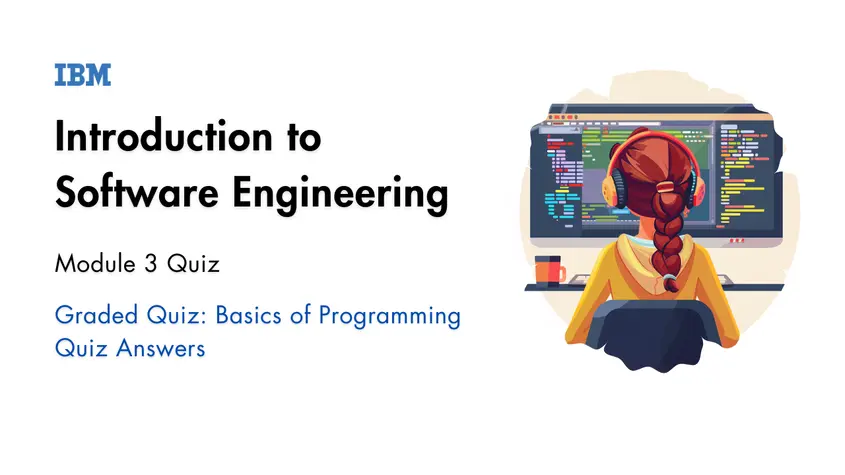Introduction to Software Engineering Module 3 Quiz Answers
In this blog post, you’ll find the complete answers for the “Introduction to Software Engineering” course by IBM on Coursera. Specifically, we cover the Module 3 Quiz: Graded Quiz: Basics of Programming. If you’re looking for accurate and up-to-date quiz answers for the Basics of Programming, this post will help you succeed in your course and enhance your understanding of key software engineering concepts.
Introduction to Software
Engineering Module 3 Quiz Answers
Graded Quiz: Basics of Programming Quiz Answers
Question 1)
Which of the following is the generic term for referencing a program component such as a stored value, method, interface, or class by a custom-named label?
- Variable
- Container
- Constant
- Identifier
Explanation: An identifier is a custom-named label used to reference program components like variables, methods, and classes.
Question 2)
Which one of the following applies to interpreted programming languages?
- Available to users who have the same operating system or a device that understands the same language
- More difficult to write in, but creates faster applications
- A smaller program, normally scripted code, that must be created and repeated every time the code is run
- Better for programs installed on the computer or device
Explanation: Interpreted languages translate code at runtime, requiring the interpreter each time the code is executed.
Question 3)
Which one of the following applies to a compiled programming language compared to an interpreted language?
- Creates a smaller program, normally using scripted code
- Better for websites and smaller processes that need to be repeated
- Takes longer to write the code, but it runs faster
- Easier to learn and use, but requires an interpreter that can translate the source code into machine code
Explanation: Compiled languages convert code into machine code before execution, resulting in faster performance compared to interpreted languages.
Question 4)
Which one of the following is an example of a low-level programming language?
- SQL
- Python
- Pascal
- ARM
Explanation: ARM is a low-level programming language used for writing instructions for processors.
Question 5)
Which of the following is a type of programming logic with only two values, “true” or “false”, and is used in both branching and looping programming logic?
- Branching statements
- “if-then-else” statement
- Boolean expression
- “And-do-while” loop
Explanation: Boolean expressions evaluate to either “true” or “false” and are used in decision-making and looping.
Question 6)
What are the three key standpoints for organizing code?
- Maintainability, accessibility, and scalability
- Readability, scalability, and accessibility
- Readability, maintainability, and scalability
- Readability, maintainability, and accessibility
Explanation: These are the key principles for organizing code to ensure it can be easily understood, maintained, and scaled.
Question 7)
Which of the following is also often referred to as a scripting language?
- An assembly programming language
- An interpreted programming language
- A compiled programming language
- A query language
Explanation: Scripting languages are typically interpreted, meaning they are executed line-by-line at runtime.
Question 8)
Which of the following is a type of looping programming logic?
- if
- goto
- while
- switch
Explanation: “while” is a type of looping logic that repeats a block of code while a condition is true.
Question 9)
Which of the following is the best type of identifier for a data item whose value does not change?
- Array
- Constant
- Variable
- Vector
Explanation: A constant is a data item whose value does not change throughout the program’s execution.
Check out also: Introduction to Software Engineering Module 2 Quiz Answers
Question 10)
Which of the following is a software methodology that focuses on objects rather than functions?
- Modular programming
- Extreme programming
- OOP
- SDLC
Explanation: Object-Oriented Programming (OOP) focuses on objects and encapsulates data and functions within those objects.



